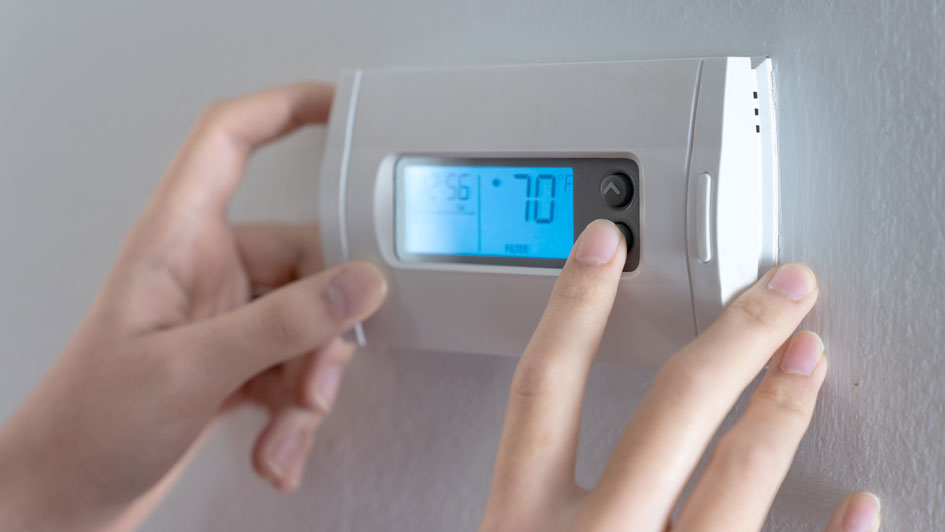
We all like saving money on our monthly utility bills, but it turns out there’s a way to keep costs down, even when you're out of the house.
The secret is your thermostat. By using automatic schedules, you can tailor the temperature to your needs. This means establishing various temperature settings for when you’re home, away or even when you’re asleep.
With a few simple adjustments, you can enjoy comfy temperatures while cutting down your energy bills. Take a look at a few ways your thermostat can be a source of energy savings:
While at Home
Whenever you're at home, you want a nice range of pleasant temperatures. For the most part, you probably have your thermostat lower in the summer if you're indoors to make the most of the cool air.
But the most energy-efficient temperatures for the summer is in fact anywhere between 78 and 80 degrees Fahrenheit. With this adjustment, you'll keep cool while still keeping your energy bills low.
While Out of the House
When setting the temperature for a vacation or other trip away from the house, it's extremely common to move the thermostat higher than normal.
For some homes, you can set the thermostat to higher temperatures like 88 degrees while no one is home before you adjust it back to the sweet spot of 78-80 degrees after you return. This way, your air conditioning system isn't working around the clock to cool an empty house.
While Sleeping
For a full night's rest during summer weather, you want a nice cool temperature. A good rule of thumb is between 68-72 degrees Fahrenheit. This will keep you from getting too hot or too cold while you're trying to sleep.
Additional Ways to Reduce Energy Use:
- Install a smart thermostat: Using a smart thermostat in the summer helps save money on energy costs since it can plan your temperature adjustments according to your lifestyle and personal preferences. A smart thermostat manages the temperature if you are home or sleeping, before allowing it to get a little warmer when no one is home. With models like the Lennox iComfort, you have the ability to remotely access and change the temperature through your smartphone, tablet or laptop. Scheduling smart thermostat installation in your The Bay Area home can be the simplest strategy for maintaining comfortable, yet energy-efficient temperatures whether you're at home or across the country.
- Upgrade your HVAC system: Upgrading your HVAC system is another great option for long-term energy savings. If a system boasts high energy efficiency, you can also count on lower utility bills since more efficient equipment requires less energy to achieve comfortable temperatures. Air conditioning installation in The Bay Area is a breeze for experienced professionals like Contra Costa Heating & AC.
- Schedule annual AC maintenance: Hiring a skilled professional to perform regular air conditioning maintenance in The Bay Area can have a significant impact on your utility bills. With regular cleaning of the coils, checking for damage and clearing ventilation of dust and debris, you may notice your HVAC system run more efficiently. More efficient operation reduces strain on important or delicate components and lowers operational costs, resulting in lower energy usage and subsequently, smaller bills.
- Clean or replace the air filter on a regular basis: A regular schedule for cleaning or replacing the HVAC system's air filter saves money by improving airflow. When filters are clogged with dirt and debris, an AC unit has to work harder, and this greater strain could shorten the system’s life span and result in breakdowns.
- Confirm your attic is sufficiently insulated: Insulation is one of the key components in any energy-efficient home, securing the hot air outside and the cool air inside over the summer. The North American Insulation Manufacturers Association (NAIMA) offers an official recommendation stating homeowners in souther states should install at least 13-14 inches of insulation, while those in northern U.S. states should have 16-18 inches.
- Inspect your air ducts: A leak in the air ducts could increase your energy bills much more than 20 percent, plus it can also lead to problems with your water heater, clothes dryer and other appliances to get into the atmosphere of your home. Watching for signs of leaks and sealing them can address both concerns.
- Seal all other leaky spots in your home: Finding and sealing any remaining leaks in your home with caulk, foam sealant or weather-stripping keeps temperatures a little cooler on hot summer days. Don't forget to check for any gaps around windows, doors and even outdoor fixtures. Making time to seal leaks now can help you save a lot in the long run.

